
Fig 4.27 shows the open circuit failures in a transistor. We shall discuss the circuit behaviour in each case.
(i) Open emitter: Fig. 4.27 (i) shows an open emitter failure in a transistor. Since the collector diode is not forward biased, it is OFF and there can be neither collector current nor base current.
Therefore, there will be no voltage drops across either resistor and the voltage at the base and at the collector leads of the transistor will be 12V.
(ii) Open-base: Fig. 4.27 (ii) shows an open base failure in a transistor. Since the base is open, there can be no base current so that the transistor is in cut-off. Therefore, all the transistor currents are 0A. In this case, the base and collector voltages will both be at 12V.
Note It may be noted that an open failure at either the base or emitter will produce similar results.
(iii) Open collector: Fig. 4.27 (iii) shows an open collector failure in a transistor. In this case, the emitter diode is still ON, so we expect to see 0.7V at the base. However, we will see 12V at the collector because there is no collector current.
Wilfykil answered the question on August 14, 2019 at 13:46
-
A transistor has the following ratings: IC (max) = 500 mA and ßmax = 300.
(Solved)
A transistor has the following ratings: IC (max) = 500 mA and ßmax = 300. Determine the maximum allowable value of IB for the device.
Date posted:
August 14, 2019
.
Answers (1)
-
In a transistor, IB = 68 µA, IE = 30 mA and ß = 440.
(Solved)
In a transistor, IB = 68 µA, IE = 30 mA and ß = 440. Determine the a rating of the
transistor. Then determine the value of IC using both the a rating and ß rating of the transistor.
Date posted:
August 14, 2019
.
Answers (1)
-
A transistor is connected in common emitter (CE) configuration in which collector supply is 8V and the voltage drop across resistance RC connected in the...
(Solved)
A transistor is connected in common emitter (CE) configuration in which collector supply is 8V and the voltage drop across resistance RC connected in the collector circuit is 0.5V. The value of RC = 800 ohms. If α = 0.96, determine:
(i) collector-emitter voltage
(ii) base current
Date posted:
August 14, 2019
.
Answers (1)
-
For a transistor, ß = 45 and voltage drop across 1 kilo-ohm which is connected in the collector circuit is 1 volt.
(Solved)
For a transistor, β = 45 and voltage drop across 1 kilo-ohm which is connected in the collector circuit is 1 volt. Find the base current for common emitter connection.
Date posted:
August 14, 2019
.
Answers (1)
-
Find the a rating of the transistor shown in Fig. 4.20. Hence determine the value of IC using both a and ß rating of the...
(Solved)
Find the α rating of the transistor shown in Fig. 4.20. Hence determine the value of IC using both α and β rating of the transistor.
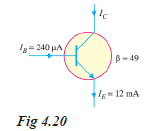
Date posted:
August 14, 2019
.
Answers (1)
-
Calculate IE in a transistor for which ß = 50 and IB = 20 µA.
(Solved)
Calculate IE in a transistor for which β = 50 and IB = 20 μA.
Date posted:
August 14, 2019
.
Answers (1)
-
Explain the Common Emitter Connection in transistors
(Solved)
Explain the Common Emitter Connection in transistors
Date posted:
August 14, 2019
.
Answers (1)
-
A common base transistor amplifier has an input resistance of 20 ohms and output resistance of 100 kilo-ohms.
(Solved)
A common base transistor amplifier has an input resistance of 20 ohms and output resistance of 100 kilo-ohms. The collector load is 1 kilo-ohm. If a signal of 500 mV is applied between emitter and base, find the voltage amplification. Assume aac to be nearly one
Date posted:
August 14, 2019
.
Answers (1)
-
Over what range of input voltage will the Zener circuit shown in Fig. 3.68 maintain 30 V across 2000 O load, assuming that series resistance...
(Solved)
Over what range of input voltage will the Zener circuit shown in Fig. 3.68 maintain 30 V across 2000 Ω load, assuming that series resistance R = 200 Ω and Zener current rating is 25 mA ?
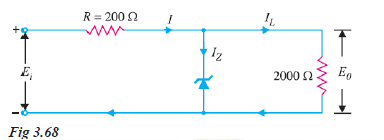
Date posted:
August 14, 2019
.
Answers (1)
-
What value of series resistance is required when three 10-watt, 10-volt, 1000 mA Zener diodes are connected in series to obtain a 30-volt regulated output...
(Solved)
What value of series resistance is required when three 10-watt, 10-volt, 1000 mA Zener diodes are connected in series to obtain a 30-volt regulated output from a 45 volt d.c. power source ?
Date posted:
August 14, 2019
.
Answers (1)
-
The circuit of Fig. 3.66 uses two Zener diodes, each rated at 15 V, 200 mA.
(Solved)
The circuit of Fig. 3.66 uses two Zener diodes, each rated at 15 V, 200 mA. If the circuit is connected to a 45-volt unregulated supply, determine:
(i) The regulated output voltage
(ii) The value of series resistance R
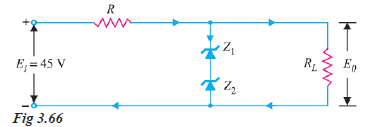
Date posted:
August 14, 2019
.
Answers (1)
-
A 10-V Zener diode is used to regulate the voltage across a variable load resistor [See fig. 3.65].
(Solved)
A 10-V Zener diode is used to regulate the voltage across a variable load resistor [See fig. 3.65]. The input voltage varies between 13 V and 16 V and the load current varies between 10 mA and 85 mA. The minimum Zener current is 15 mA. Calculate the value of series resistance R.

Date posted:
August 14, 2019
.
Answers (1)
-
A 7.2 V Zener is used in the circuit shown in Fig. 3.63 and the load current is to vary from 12 to 100 mA.
(Solved)
A 7.2 V Zener is used in the circuit shown in Fig. 3.63 and the load current is to vary from 12 to 100 mA. Find the value of series resistance R to maintain a voltage of 7.2 V across the load. The input voltage is constant at 12V and the minimum Zener current is 10 mA.

Date posted:
August 14, 2019
.
Answers (1)
-
For the circuit shown in Fig. 3.62 (i), find the maximum and minimum values of Zener diode current.
(Solved)
For the circuit shown in Fig. 3.62 (i), find the maximum and minimum values of Zener diode current.

Date posted:
August 14, 2019
.
Answers (1)
-
Determine the state of diode for the circuit shown in Fig. 3.18 (i) and find ID and VD. Assume simplified model for the diode.
(Solved)
Determine the state of diode for the circuit shown in Fig. 3.18 (i) and find ID and VD. Assume simplified model for the diode.

Date posted:
August 14, 2019
.
Answers (1)
-
Determine if the diode (ideal) in Fig. 3.17 (i) is forward biased or reverse biased.
(Solved)
Determine if the diode (ideal) in Fig. 3.17 (i) is forward biased or reverse biased.
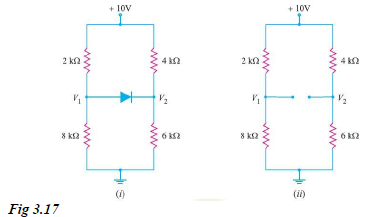
Date posted:
August 14, 2019
.
Answers (1)
-
Determine the currents I1, I2 and I3 for the network shown in Fig. 3.16
(Solved)
Determine the currents I1, I2 and I3 for the network shown in Fig. 3.16(i). Use simplified model for the diodes.
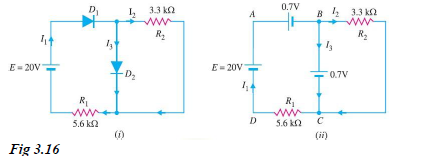
Date posted:
August 14, 2019
.
Answers (1)
-
Determine current through each diode in the circuit shown in Fig. 3.15
(Solved)
Determine current through each diode in the circuit shown in Fig. 3.15 (i). Use simplified model. Assume diodes to be similar.
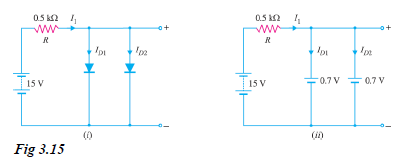
Date posted:
August 14, 2019
.
Answers (1)
-
Find VQ and ID in the network shown in Fig. 3.14 (i). Use simplified model
(Solved)
Find VQ and ID in the network shown in Fig. 3.14 (i). Use simplified model
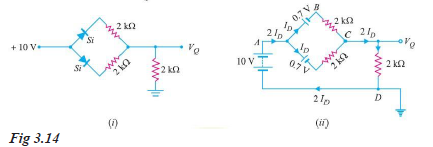
Date posted:
August 14, 2019
.
Answers (1)
-
Find the voltage VA in the circuit shown in Fig. 3.13 (i). Use simplified model.
(Solved)
Find the voltage VA in the circuit shown in Fig. 3.13 (i). Use simplified model.
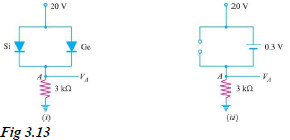
Date posted:
August 14, 2019
.
Answers (1)